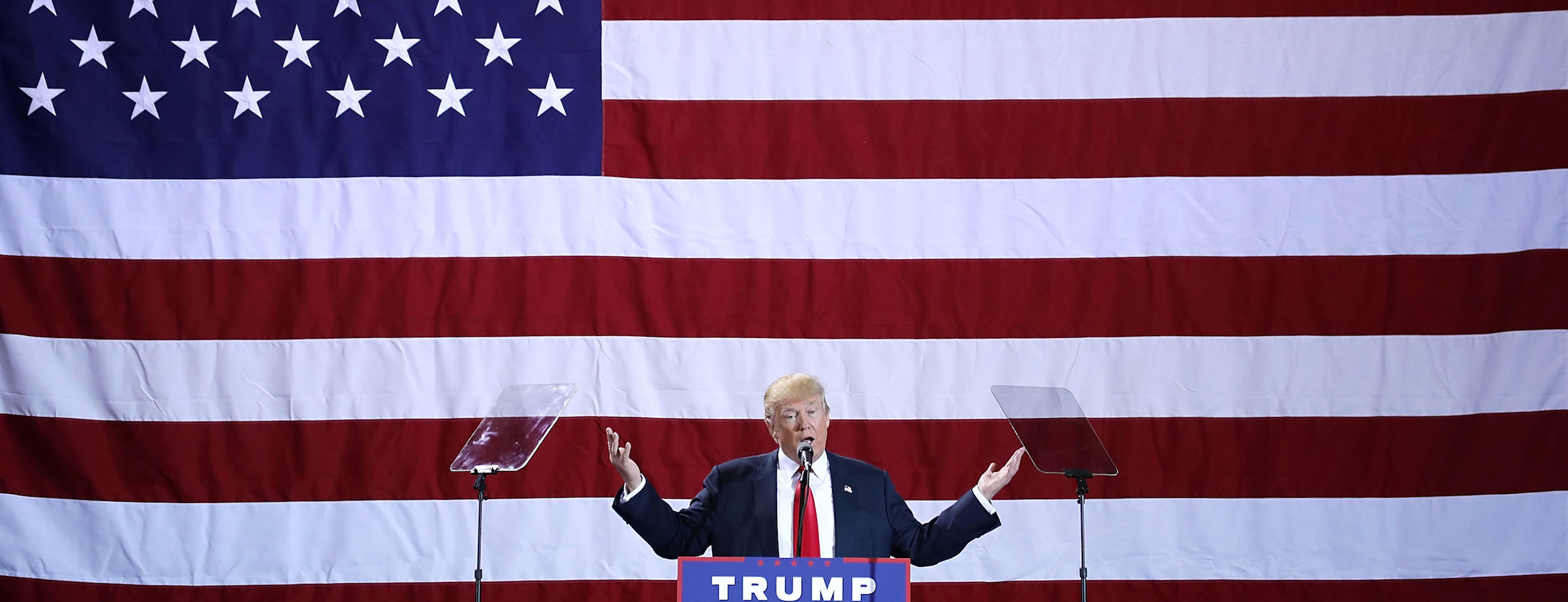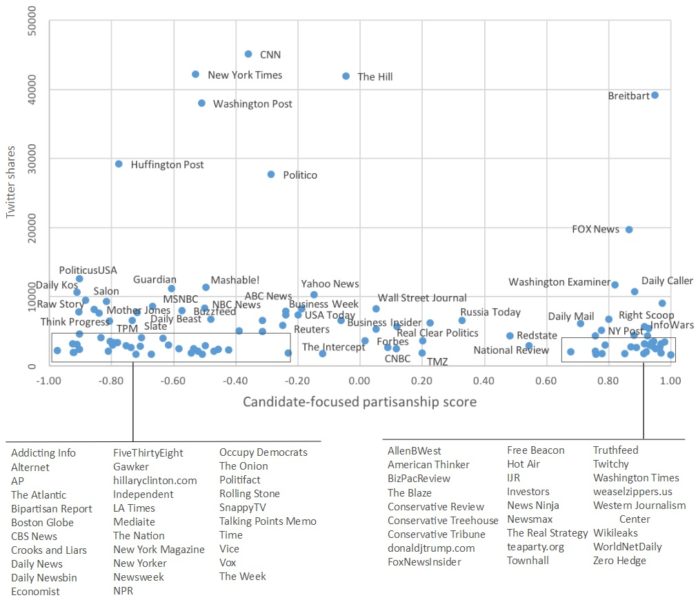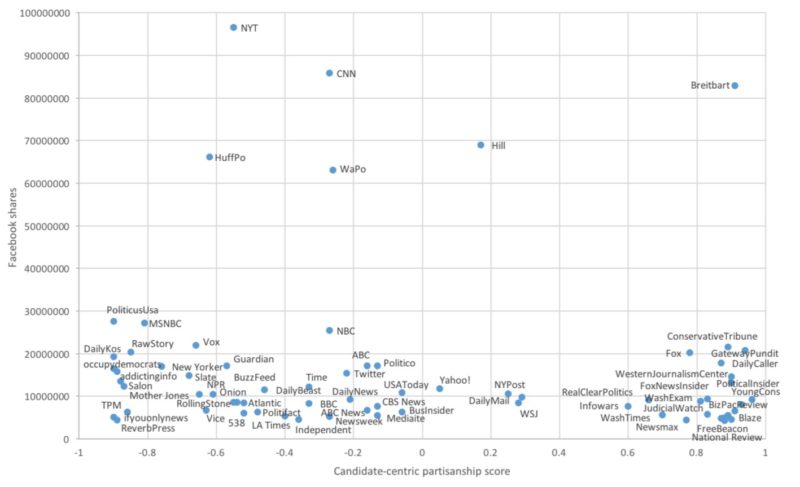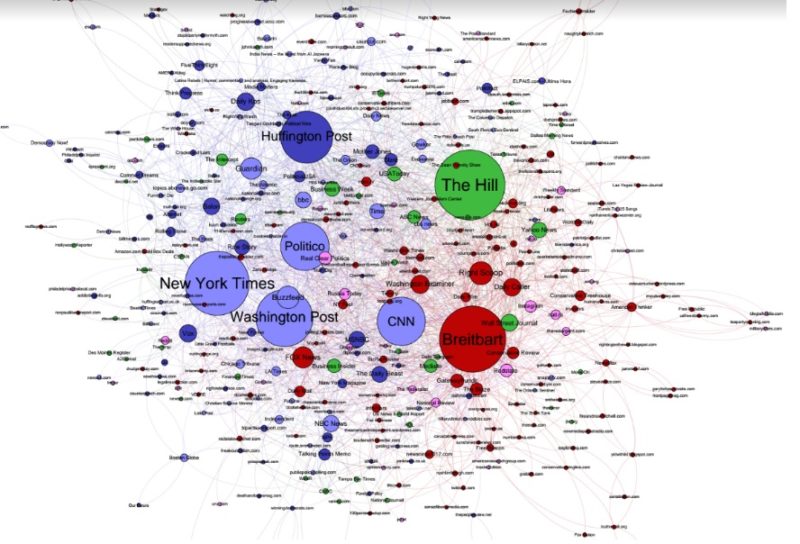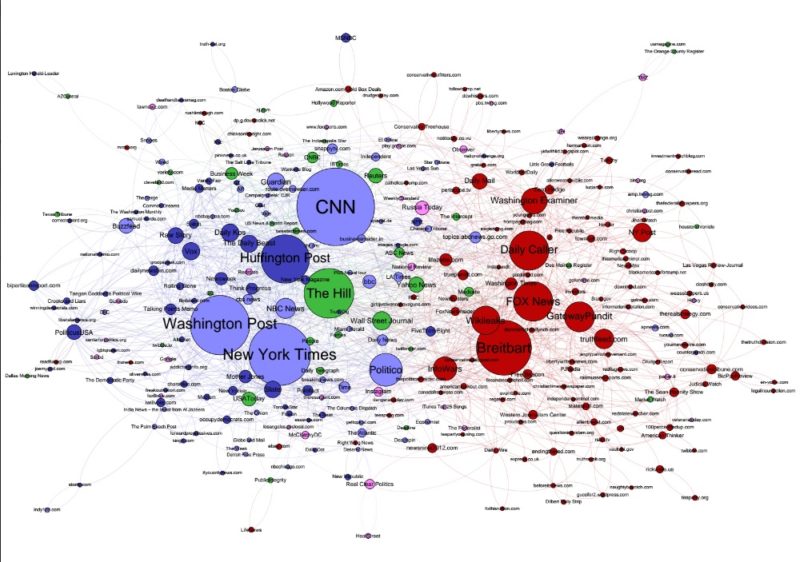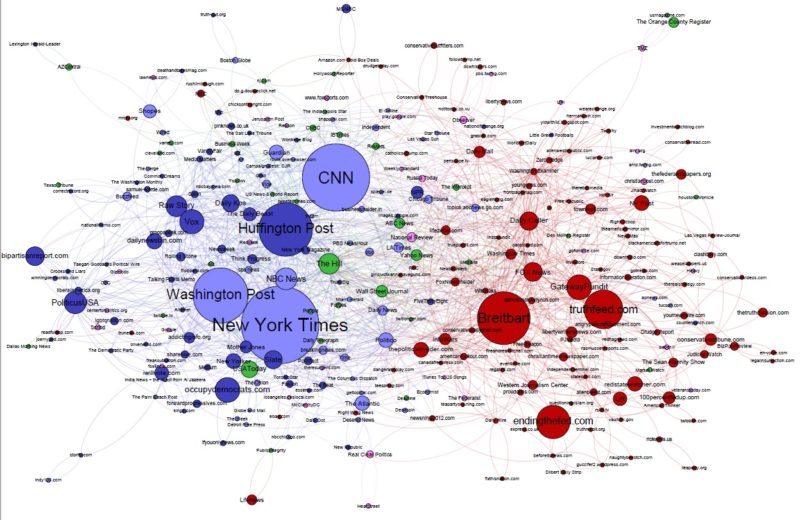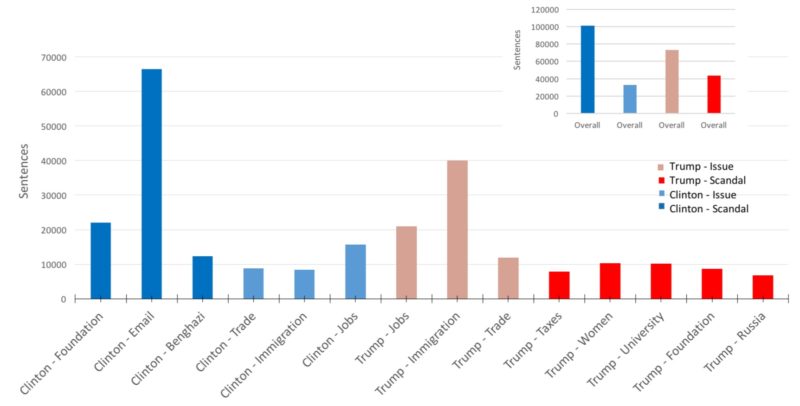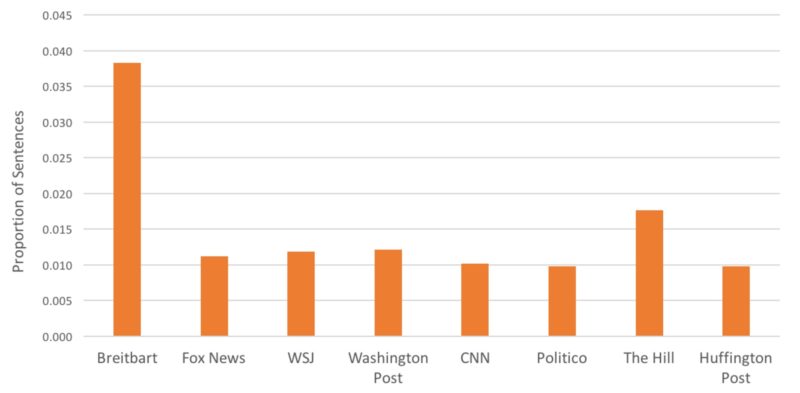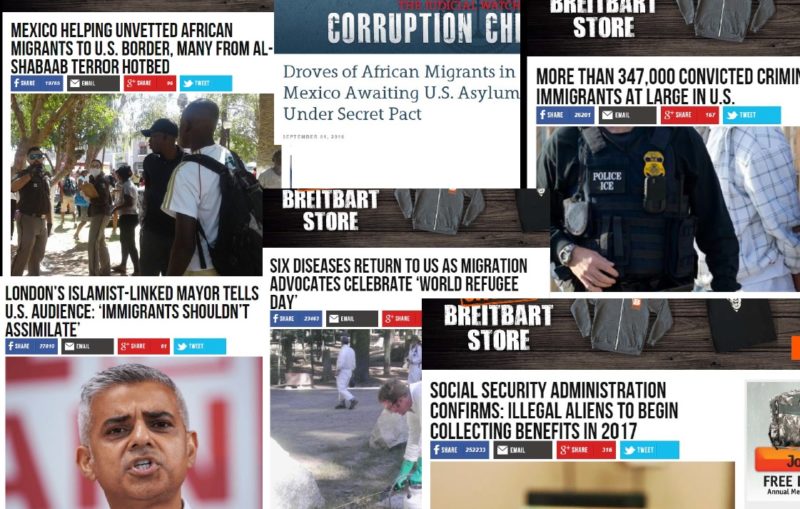The 2016 Presidential election shook the foundations of American politics. Media reports immediately looked for external disruption to explain the unanticipated victory—with theories ranging from Russian hacking to “fake news.”
We have a less exotic, but perhaps more disconcerting explanation: Our own study of over 1.25 million stories published online between April 1, 2015 and Election Day shows that a right-wing media network anchored around Breitbart developed as a distinct and insulated media system, using social media as a backbone to transmit a hyper-partisan perspective to the world. This pro-Trump media sphere appears to have not only successfully set the agenda for the conservative media sphere, but also strongly influenced the broader media agenda, in particular coverage of Hillary Clinton.
While concerns about political and media polarization online are longstanding, our study suggests that polarization was asymmetric. Pro-Clinton audiences were highly attentive to traditional media outlets, which continued to be the most prominent outlets across the public sphere, alongside more left-oriented online sites. But pro-Trump audiences paid the majority of their attention to polarized outlets that have developed recently, many of them only since the 2008 election season.
Attacks on the integrity and professionalism of opposing media were also a central theme of right-wing media. Rather than “fake news” in the sense of wholly fabricated falsities, many of the most-shared stories can more accurately be understood as disinformation: the purposeful construction of true or partly true bits of information into a message that is, at its core, misleading. Over the course of the election, this turned the right-wing media system into an internally coherent, relatively insulated knowledge community, reinforcing the shared worldview of readers and shielding them from journalism that challenged it. The prevalence of such material has created an environment in which the President can tell supporters about events in Sweden that never happened, or a presidential advisor can reference a non-existent “Bowling Green massacre.”
RELATED: Breitbart editor slams mainstream media in Pulitzer Hall
We began to study this ecosystem by looking at the landscape of what sites people share. If a person shares a link from Breitbart, is he or she more likely also to share a link from Fox News or from The New York Times? We analyzed hyperlinking patterns, social media sharing patterns on Facebook and Twitter, and topic and language patterns in the content of the 1.25 million stories, published by 25,000 sources over the course of the election, using Media Cloud, an open-source platform for studying media ecosystems developed by Harvard’s Berkman Klein Center for Internet & Society and MIT’s Center for Civic Media.
When we map media sources this way, we see that Breitbart became the center of a distinct right-wing media ecosystem, surrounded by Fox News, the Daily Caller, the Gateway Pundit, the Washington Examiner, Infowars, Conservative Treehouse, and Truthfeed.
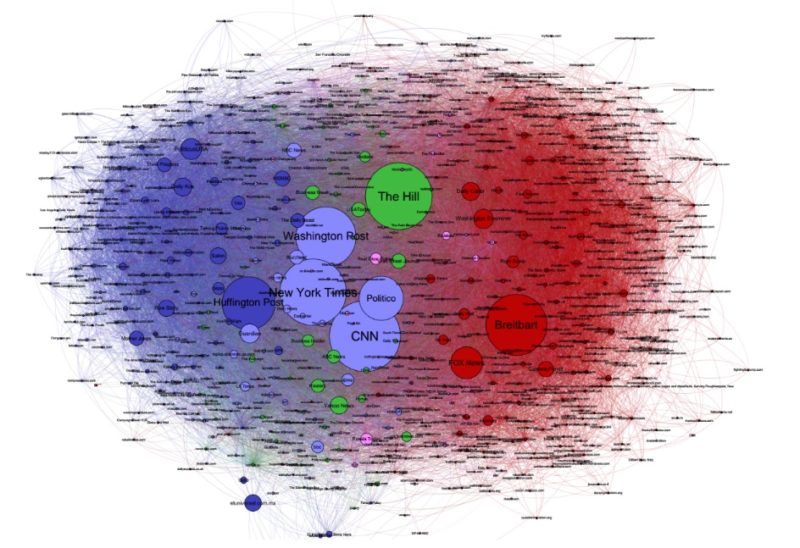
Fig. 1: Media sources shared on Twitter during the election (nodes sized in proportion to Twitter shares).
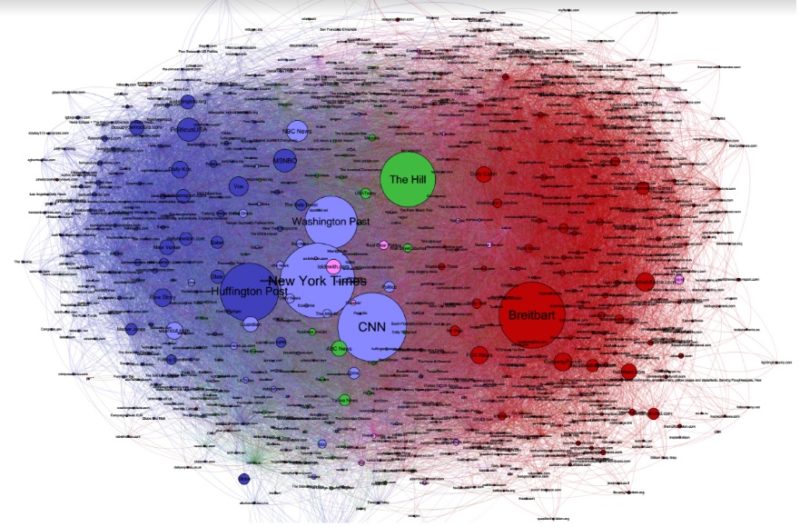
Fig. 2: Media sources shared on Twitter during the election (nodes sized in proportion to Facebook shares).
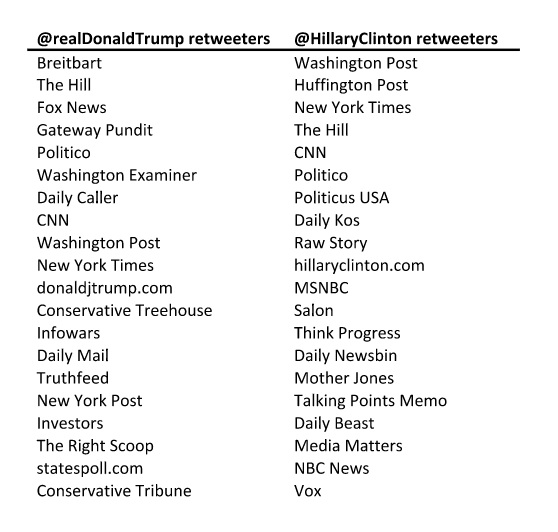
The most frequently shared media sources for Twitter users that retweeted either Trump or Clinton.
Notes: In the above clouds, the nodes are sized according to how often they were shared on Twitter (Fig. 1) or Facebook (Fig. 2). The location of nodes is determined by whether two sites were shared by the same Twitter user on the same day, representing the extent to which two sites draw similar audiences. The colors assigned to a site in the map reflect the share of that site’s stories tweeted by users who also retweeted either Clinton or Trump during the election. These colors therefore reflect the attention patterns of audiences, not analysis of content of the sites. Dark blue sites draw attention in ratios of at least 4:1 from Clinton followers; red sites 4:1 Trump followers. Green sites are retweeted more or less equally by followers of each candidate. Light-blue sites draw 3:2 Clinton followers, and pink draw 3:2 Trump followers.
Our analysis challenges a simple narrative that the internet as a technology is what fragments public discourse and polarizes opinions, by allowing us to inhabit filter bubbles or just read “the daily me.” If technology were the most important driver towards a “post-truth” world, we would expect to see symmetric patterns on the left and the right. Instead, different internal political dynamics in the right and the left led to different patterns in the reception and use of the technology by each wing. While Facebook and Twitter certainly enabled right-wing media to circumvent the gatekeeping power of traditional media, the pattern was not symmetric.
The size of the nodes marking traditional professional media like The New York Times, The Washington Post, and CNN, surrounded by the Hill, ABC, and NBC, tell us that these media drew particularly large audiences. Their color tells us that Clinton followers attended to them more than Trump followers, and their proximity on the map to more quintessentially partisan sites—like Huffington Post, MSNBC, or the Daily Beast—suggests that attention to these more partisan outlets on the left was more tightly interwoven with attention to traditional media. The Breitbart-centered wing, by contrast, is farther from the mainstream set and lacks bridging nodes that draw attention and connect it to that mainstream.
RELATED: 10 tools to tackle common problems journalists face
Moreover, the fact that these asymmetric patterns of attention were similar on both Twitter and Facebook suggests that human choices and political campaigning, not one company’s algorithm, were responsible for the patterns we observe. These patterns might be the result of a coordinated campaign, but they could also be an emergent property of decentralized behavior, or some combination of both. Our data to this point cannot distinguish between these alternatives.
Another way of seeing this asymmetry is to graph how much attention is given to sites that draw attention mostly from one side of the partisan divide. There are very few center-right sites: sites that draw many Trump followers, but also a substantial number of Clinton followers. Between the moderately conservative Wall Street Journal, which draws Clinton and Trump supporters in equal shares, and the starkly partisan sites that draw Trump supporters by ratios of 4:1 or more, there are only a handful of sites. Once a threshold of partisan-only attention is reached, the number of sites in the clearly partisan right increases, and indeed exceeds the number of sites in the clearly partisan left. By contrast, starting at The Wall Street Journal and moving left, attention is spread more evenly across a range of sites whose audience reflects a gradually increasing proportion of Clinton followers as opposed to Trump followers. Unlike on the right, on the left there is no dramatic increase in either the number of sites or levels of attention they receive as we move to more clearly partisan sites.
The primary explanation of such asymmetric polarization is more likely politics and culture than technology.
A remarkable feature of the right-wing media ecosystem is how new it is. Out of all the outlets favored by Trump followers, only the New York Post existed when Ronald Reagan was elected president in 1980. By the election of Bill Clinton in 1992, only the Washington Times, Rush Limbaugh, and arguably Sean Hannity had joined the fray. Alex Jones of Infowars started his first outlet on the radio in 1996. Fox News was not founded until 1996. Breitbart was founded in 2007, and most of the other major nodes in the right-wing media system were created even later. Outside the right-wing, the map reflects a mixture of high attention to traditional journalistic outlets and dispersed attention to new, online-only, and partisan media.
The pattern of hyper-partisan attack was set during the primary campaign, targeting not only opposing candidates but also media that did not support Trump’s candidacy. In our data, looking at the most widely-shared stories during the primary season and at the monthly maps of media during those months, we see that Jeb Bush, Marco Rubio, and Fox News were the targets of attack.

The first and seventh most highly-tweeted stories from Infowars.com, one of the 10 most influential sites in the right-wing media system.
The February map, for example, shows Fox News as a smaller node quite distant from the Breitbart-centered right. It reflects the fact that Fox News received less attention than it did earlier or later in the campaign, and less attention, in particular, from users who also paid attention to the core Breitbart-centered sites and whose attention would have drawn Fox closer to Breitbart. The March map is similar, and only over April and May will Fox’s overall attention and attention from Breitbart followers revive.
This sidelining of Fox News in early 2016 coincided with sustained attacks against it by Breitbart. The top-20 stories in the right-wing media ecology during January included, for example, “Trump Campaign Manager Reveals Fox News Debate Chief Has Daughter Working for Rubio.” More generally, the five most-widely shared stories in which Breitbart refers to Fox are stories aimed to delegitimize Fox as the central arbiter of conservative news, tying it to immigration, terrorism and Muslims, and corruption:
- The Anti-Trump Network: Fox News Money Flows into Open Borders Group;
- NY Times Bombshell Scoop: Fox News Colluded with Rubio to Give Amnesty to Illegal Aliens;
- Google and Fox TV Invite Anti-Trump, Hitler-Citing, Muslim Advocate to Join Next GOP TV-Debate;
- Fox, Google Pick 1994 Illegal Immigrant To Ask Question In Iowa GOP Debate;
- Fox News At Facebook Meeting Is Misdirection: Murdoch and Zuckerberg Are Deeply Connected Over Immigration.
The repeated theme of conspiracy, corruption, and media betrayal is palpable in these highly shared Breitbart headlines linking Fox News, Rubio, and illegal immigration.
As the primaries ended, our maps show that attention to Fox revived and was more closely integrated with Breitbart and the remainder of the right-wing media sphere. The primary target of the right-wing media then became all other traditional media. While the prominence of different media sources in the right-wing sphere vary when viewed by shares on Facebook and Twitter, the content and core structure, with Breitbart at the center, is stable across platforms. Infowars, and similarly radical sites Truthfeed and Ending the Fed, gain in prominence in the Facebook map.
These two maps reveal the same pattern. Even in the highly-charged pre-election month, everyone outside the Breitbart-centered universe forms a tightly interconnected attention network, with major traditional mass media and professional sources at the core. The right, by contrast, forms its own insular sphere.
The right-wing media was also able to bring the focus on immigration, Clinton emails, and scandals more generally to the broader media environment. A sentence-level analysis of stories throughout the media environment suggests that Donald Trump’s substantive agenda—heavily focused on immigration and direct attacks on Hillary Clinton—came to dominate public discussions.
Coverage of Clinton overwhelmingly focused on emails, followed by the Clinton Foundation and Benghazi. Coverage of Trump included some scandal, but the most prevalent topic of Trump-focused stories was his main substantive agenda item—immigration—and his arguments about jobs and trade also received more attention than his scandals.
While mainstream media coverage was often critical, it nonetheless revolved around the agenda that the right-wing media sphere set: immigration. Right-wing media, in turn, framed immigration in terms of terror, crime, and Islam, as a review of Breitbart and other right-wing media stories about immigration most widely shared on social media exhibits. Immigration is the key topic around which Trump and Breitbart found common cause; just as Trump made this a focal point for his campaign, Breitbart devoted disproportionate attention to the topic.
What we find in our data is a network of mutually-reinforcing hyper-partisan sites that revive what Richard Hofstadter called “the paranoid style in American politics,” combining decontextualized truths, repeated falsehoods, and leaps of logic to create a fundamentally misleading view of the world. “Fake news,” which implies made of whole cloth by politically disinterested parties out to make a buck of Facebook advertising dollars, rather than propaganda and disinformation, is not an adequate term. By repetition, variation, and circulation through many associated sites, the network of sites make their claims familiar to readers, and this fluency with the core narrative gives credence to the incredible.
Take a look at Ending the Fed, which, according to Buzzfeed’s examination of fake news in November 2016, accounted for five of the top 10 of the top fake stories in the election. In our data, Ending the Fed is indeed prominent by Facebook measures, but not by Twitter shares. In the month before the election, for example, it was one of the three most-shared right-wing sites on Facebook, alongside Breitbart and Truthfeed. While Ending the Fed clearly had great success marketing stories on Facebook, our analysis shows nothing distinctive about the site—it is simply part-and-parcel of the Breitbart-centered sphere.
And the false claims perpetuated in Ending the Fed’s most-shared posts are well established tropes in right wing media: the leaked Podesta emails, alleged Saudi funding of Clinton’s campaign, and a lack of credibility in media. The most Facebook-shared story by Ending the Fed in October was “IT’S OVER: Hillary’s ISIS Email Just Leaked & It’s Worse Than Anyone Could Have Imagined.” See also, Infowars’ “Saudi Arabia has funded 20% of Hillary’s Presidential Campaign, Saudi Crown Prince Claims,” and Breitbart’s “Clinton Cash: Khizr Khan’s Deep Legal, Financial Connections to Saudi Arabia, Hillary’s Clinton Foundation Tie Terror, Immigration, Email Scandals Together.” This mix of claims and facts, linked through paranoid logic characterizes much of the most shared content linked to Breitbart. It is a mistake to dismiss these stories as “fake news”; their power stems from a potent mix of verifiable facts (the leaked Podesta emails), familiar repeated falsehoods, paranoid logic, and consistent political orientation within a mutually-reinforcing network of like-minded sites.
Use of disinformation by partisan media sources is neither new nor limited to the right wing, but the insulation of the partisan right-wing media from traditional journalistic media sources, and the vehemence of its attacks on journalism in common cause with a similarly outspoken president, is new and distinctive.
Rebuilding a basis on which Americans can form a shared belief about what is going on is a precondition of democracy, and the most important task confronting the press going forward. Our data strongly suggest that most Americans, including those who access news through social networks, continue to pay attention to traditional media, following professional journalistic practices, and cross-reference what they read on partisan sites with what they read on mass media sites.
To accomplish this, traditional media needs to reorient, not by developing better viral content and clickbait to compete in the social media environment, but by recognizing that it is operating in a propaganda and disinformation-rich environment. This, not Macedonian teenagers or Facebook, is the real challenge of the coming years. Rising to this challenge could usher in a new golden age for the Fourth Estate.
The election study was funded by the Open Society Foundations U.S. Program. Media Cloud has received funding from The Bill and Melinda Gates Foundation, the Robert Woods Johnson Foundation, the Ford Foundation, and the Open Societies Foundations.
Yochai Benkler, Robert Faris, Hal Roberts, and Ethan Zuckerman are the authors. Benkler is a professor at Harvard Law School and codirector of the Berkman Klein Center for Internet and Society at Harvard (BKC); Faris is research director at BKC; Roberts is a fellow at BKC and technical lead of Media Cloud; and Zuckerman is director of the MIT Center for Civic Media.

